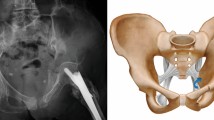Abstract
Background and aims
Proximal humerus is a common site of fracture in elderly patients, mainly related to bone fragility. Comorbidities are often present in these patients and may limit the surgical options. Not or minimal invasive treatments are commonly indicated however with variable results. The authors present their experience with conservative approach and percutaneous fixation by K-wires, focusing on their indications and main advantages on this population: mini-invasivity, acceptable reduction and recovery, and low costs.
Methods
A study group of 51 consecutive patients with a mean age of 75.5 and affected by severe comorbidities (mainly cardiac, circulatory, pneumologic, neurologic, metabolic, and nephrologic pathologies) were evaluated clinically (ASA score, VAS, muscular strength, Constant–Murley score), and with radiologic analysis: 28 patients were treated by percutaneous fixation, while 23 subjects were treated conservatively.
Results
Fractures treated by K-wires fixation healed after a mean interval of 8.2 weeks in all fractures but one, with improvements in mean Constant–Murley score (up to 80.6 points), in mean VAS (2.9), in muscular strength (4.1), and in range of motion. Fractures treated by brace healed in a mean time of 10.2 weeks. Mean Constant–Murley score improved to 76.4 points, VAS to 3.0, muscular strength to 3.8 points, and significant recovery of range of motion.
Conclusions
Results of the study confirm that both percutaneous fixation and conservative treatment may represent suitable options for proximal humerus fragility fractures in elderly patients, not candidated to open surgery for severe associated comorbidities.
Level of evidence
IV (case series study).


Similar content being viewed by others
References
Lauritzen JB, Schwarz P, Lund B, McNair P, Transbol I (1993) Changing incidence and residual lifetime risk of common osteoporosis-related fractures. Osteoporos Int 3:127–132
Palvanen M, Kannus P, Niemi S, Parkkari J (2006) Update in the epidemiology of proximal humeral fractures. Clin Orthop Relat Res 442:87–92
Giannotti S, Bottai V, Dell’osso G, Donati D, Bugelli G, De Paola G, Guido G (2012) Indices of risk assessment of fracture of the proximal humerus. Clin Cases Miner Bone Metab 9:37–39
Zyto K (1998) Non-operative treatment of comminuted fractures of the proximal humerus in elderly patients. Injury 29:349–352
Torrens C, Corrales M, Vilà G, Santana F, Cáceres E (2011) Functional and quality-of-life results of displaced and nondisplaced proximal humeral fractures treated conservatively. J Orthop Trauma 25:581–587
Zyto K, Ahrengart L, Sperbert A, Törnkvist H (1997) Treatment of displaced proximal humeral fractures in elderly patients. J Bone Jt Surg Br 79:412–417
Magovern B, Ramsey ML (2008) Percutaneous fixation of proximal humerus fractures. Orthop Clin North Am 39:405–416
Ring D (2007) Current concepts in plate and screw fixation of osteoporotic proximal humerus fractures. Injury 38(Suppl. 3):559–568
Reitman RD, Kerzhner E (2011) Reverse shoulder arthroplasty as treatment for comminuted proximal humeral fractures in elderly patients. Am J Orthop 40:458–461
Esen E, Dogramci Y, Gultekin S, Deveci MA, Suluova Fanatli U, Bolukbasi S (2009) Factors affecting results of patients with humeral proximal end fractures undergoing primary hemiarthroplasty: a retrospective study in 42 patients. Injury 40:1336–1341
Jaberg H, Warner JJ, Jakob RP (1992) Percutaneous stabilization of unstable fractures of the humerus. J Bone Jt Surg Am 74:508–515
Resch H, Povacz P, Frölich R, Wambacher M (1997) Percutaneous fixation of three- and four-part fractures of the proximal humerus. J Bone Jt Surg Br 79:295–300
Neer CR II (1970) Displaced proximal humeral fracture. Part I. Classification and evaluation. J Bone Jt Surg Am 52:1077–1089
Neer CR II (1970) Displaced proximal humeral fracture. Part II. Treatment of three-part and four-part displacement. J Bone Jt Surg Am 52:1090–1103
Dripps RD, Lamont A, Eckenhoff JE (1961) The role of anesthesia in surgical mortality. JAMA 1978:261–266
Hislop HJ, Montgomery J (2007) Daniels and Worthingham’s muscle testing, 8th edn. Saunders Elsevier, St. Louis
Constant CR, Murley AH (1987) A clinical method of functional assessment of the shoulder. Clin Orthop Relat Res 214:160–164
Kabir K, Burger C, Fischera P, Weber, Florczyk A, Goost H, Rangger C (2009) Health status as an important outcome factor after hemiarthroplasty. J Shoulder Elbow Surg 18:75–82
Keener JD, Parsons BO, Flatow EL, Rogers K, Williams GR, Galatz LM (2007) Outcomes after percutaneous reduction and fixation of proximal humerus fractures. J Shoulder Elbow Surg 16:330–338
Bogner R, Hubner C, Matis N, Auffarth A, Lederer S, Resch H (2008) Minimally-invasive treatment of three- and four- part fractures of the proximal humerus in elderly patients. J Bone Jt Surg Br 90:1602–1607
Mellado JM, Calmet J, Garcia Forcada IL, Sauri A, Giné J (2004) Early intrathoracic migration of Kirschner wires used for percutaneous osteosynthesis of a two-part humeral neck fracture: a case report. Emerg Radiol 11:49–52
Freund E, Nachman R, Gips H, Hiss J (2007) Migration of a Kirschner wire used in the fixation of a subcapital humeral fracture, causing cardiac tamponade: case report and review of literature. Am J Forensic Med Pathol 28:155–156
Acknowledgments
The Authors wish to thank Mary Lokken for her precious contribution in the revision of the manuscript.
Conflict of interest
None.
Author information
Authors and Affiliations
Corresponding author
Rights and permissions
About this article
Cite this article
Innocenti, M., Carulli, C., Civinini, R. et al. Displaced fragility fractures of proximal humerus in elderly patients affected by severe comorbidities: percutaneous fixation and conservative treatment. Aging Clin Exp Res 25, 447–452 (2013). https://doi.org/10.1007/s40520-013-0063-4
Received:
Accepted:
Published:
Issue Date:
DOI: https://doi.org/10.1007/s40520-013-0063-4




